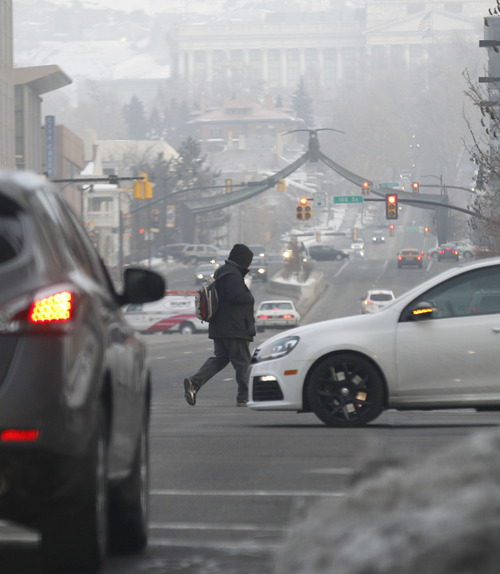This is an archived article that was published on sltrib.com in 2014, and information in the article may be outdated. It is provided only for personal research purposes and may not be reprinted.
Kennecott Utah Copper recently won state approval for a rock crushing facility west of Magna, needed to expand the 9,000-acre area it already uses to store tailings, or rock left over after mining.
But environmental groups say the state should invalidate the permit, arguing regulators failed to adequately review the crusher's air quality impacts. Their appeal says Kennecott's "fugitive" emissions would add to the airborne filth suspended over the Salt Lake Valley.
The proposed Bonneville Borrow Plant is a small but vital part of Kennecott's Bingham Canyon Mine expansion, designed to extend the life of the massive cut into the Oquirrh Mountains' east flank until at least 2029.
Utah Physicians for a Healthy Environment and Friends of Great Salt Lake filed papers last month, asking the Utah Department of Environmental Quality to reconsider approvals granted by the Division of Air Quality (DAQ) and halt the project.
Kennecott, however, is unlikely to build the crusher anytime soon because it's still recovering from the April 10 landslide that filled part of the Bingham pit and constrained production. And the expansion of the tailings area, or impoundment, is under review by the U.S. Army Corps of Engineers, which is not expected to release an Environmental Impact Statement until next year.
There would be no point in crushing rock if the feds nix the 1,200-acre expansion, which would fill about 600 acres of wetlands and extend the tailings heap east to 7200 West. It could also contaminate groundwater and the Great Salt Lake, a few miles to the northwest, environmentalists say.
Their central argument against the crusher permit is that DAQ failed to aggregate its emissions with those of Kennecott's larger operations, a move that evaded a more thorough analysis.
With the Salt Lake area's airshed out of compliance with federal standards for particulate matter, the DAQ should apply a rigorous review of emissions in the context of Kennecott's total operations, according to attorney Joro Walker, of Western Resource Advocates.
"If [the crusher] is considered part of the mining and smelting operations, then it would be considered a major modification subject to stricter requirements," Walker said. "They are mining copper and this project facilitates copper mining."
Company officials said the crusher and other upgrades at Kennecott's mine, concentrator and smelter have been designed to minimize the operation's overall emissions, which are believed to account for 3.5 percent of Salt Lake Valley's air pollution.
"It went through two public comment periods and it was a long, thorough and complete review process," said Chris Kaiser, an environmental engineer.
"The state required us to put baghouses [to capture some dust] on the conveyer transfer points," Kaiser said. "The state implemented robust requirements in this permit in response to public comments, like putting in those baghouses."
Kennecott intends to produce fine gravel to lay down as a "drainage blanket" on the floor of the expanded impoundment, then use larger rock pebbles to erect retaining walls to hold another billion tons of sandy waste material expected to come out of the ore concentrator.
The crusher permit allows Kennecott to process up to 3.7 million tons of rock a year, releasing 267 tons of large particulate matter, described as PM10. Moving this rock would result in 12,500 truck miles. The DAQ required Kennecott to "offset" these emissions by cutting 320 tons elsewhere.
According to Kaiser, Kennecott accomplished this through upgrades at its smelter.
But Walker objects, saying, "Those improvements were done a long time ago, so the air pollution we have now are with those improvements and we are still not attaining" compliance with the federal standard for fine particulate, known as PM2.5.
"They are adding 267 tons to an already contaminated airshed," Walker said.
Meanwhile, Utah Physicians for a Healthy Environment and others are suing Kennecott over the state-approved mine expansion, arguing associated emission increases are impermissible because Wasatch Front cities still struggle with unhealthy levels of particulate pollution.
The mine's plans to increase excavations from 197 to 269 million tons a year should require approval from the U.S. Environmental Protection Agency, the groups say.
Expansion is needed to extend the life of the mine, along with the economic benefits it has provided to Utah for more than a century, and Kennecott is making enormous investments in low-emission technologies and practices, according to spokesman Kyle Bennett.
For example, the mine now moves nearly all its ore through a 5-mile tunnel to the Copperton concentrator, eliminating the usual dust emissions caused by trucks. Kaiser said the mine has equipped half of its haul trucks with the most advanced emission controls and re-engineered its smelter to capture 99.9 percent of its sulphur emissions.
"We are doing what we can to be part of the solution. We are a large operation and we do have a big footprint," he said. "We are always working to reduce emissions from our regulated operations."
Share the story of your bad air day
How does poor air quality affect you? The Salt Lake Tribune and KUED Channel 7 want to hear your bad air day stories.
Send written stories to utairquality@sltrib.com or outreach@kued.org with "My Bad Air Day" in the subject line, or share them at https://www.facebook.com/saltlaketribune or https://www.facebook.com/kuedchannel7.
Share video stories on Tout at http://www.tout.com/sltrib or by using the hashtag #mybadairday on Instagram.
The Tribune and KUED will share your stories as part of our ongoing air quality coverage.



